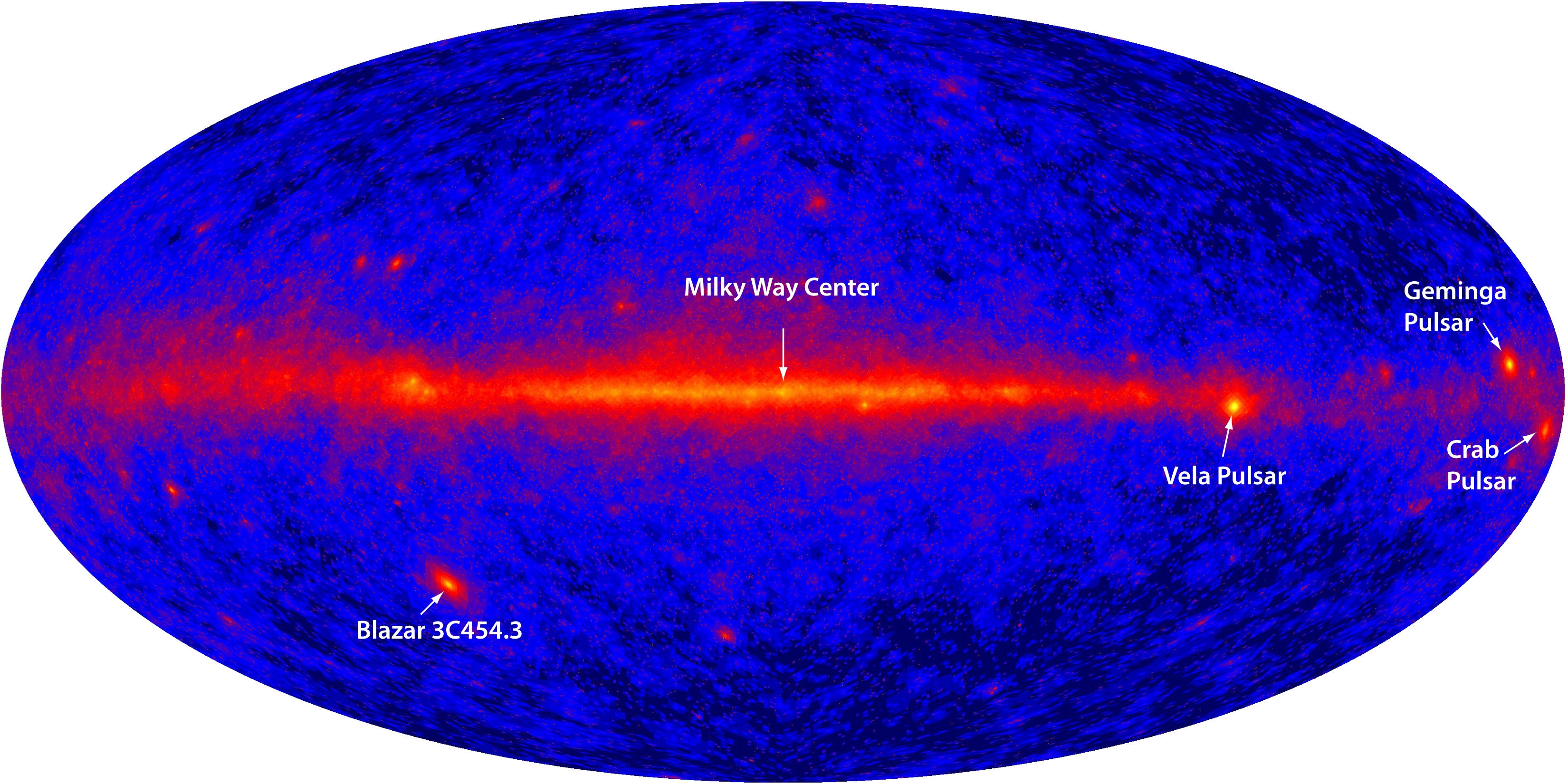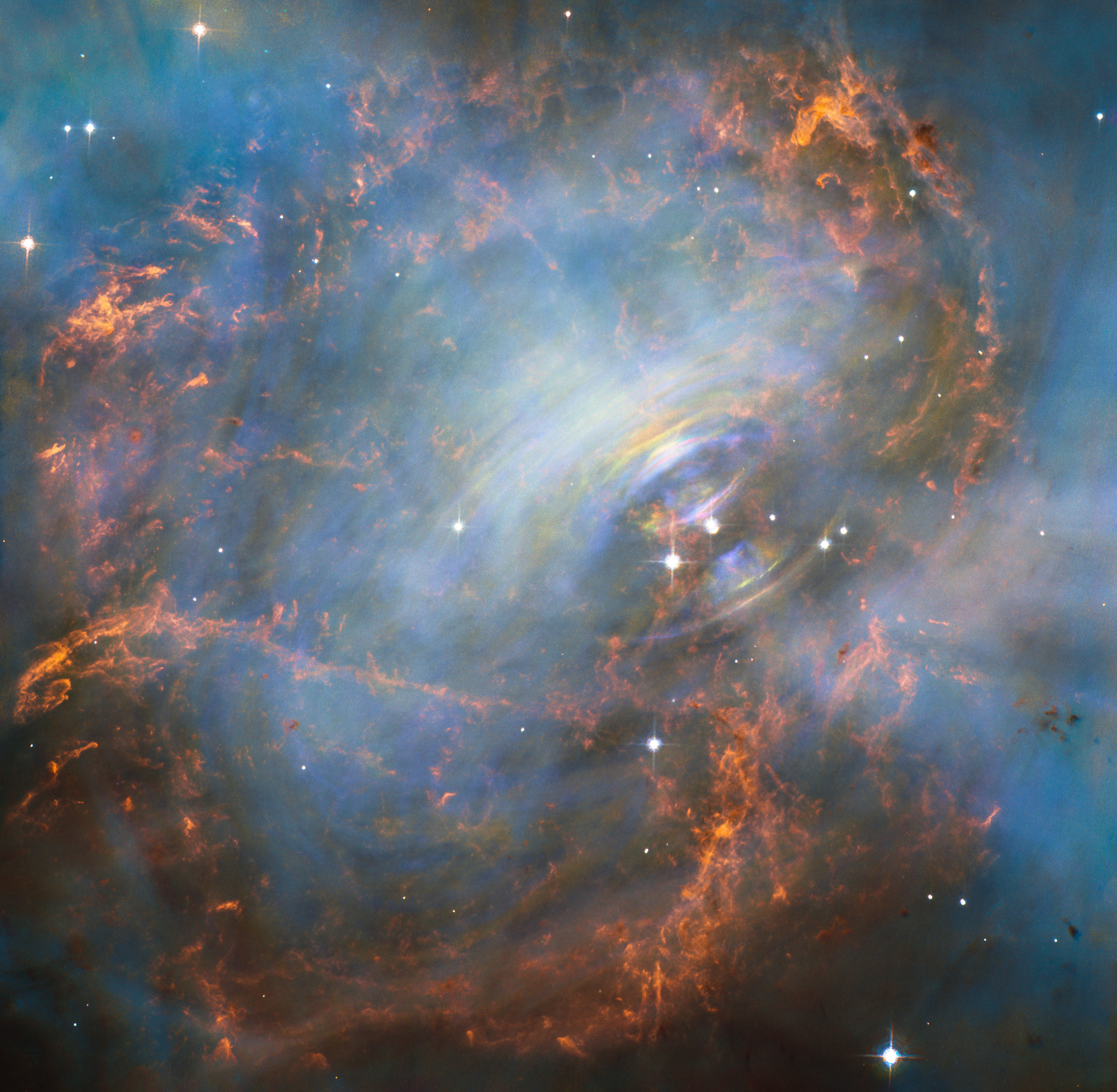|
Pulsar Glitch
In astronomy, a glitch is a sudden small increase of around 1 part in 1 million in the rotational frequency of a pulsar, which usually decreases steadily due to braking provided by the emission of radiation and high-energy particles. It is not known whether glitches are related to the timing noise which all pulsars exhibit. Following a glitch is a period of gradual recovery where the observed periodicity slows to a period close to that observed before the glitch. These gradual recovery periods have been observed to last from days to years. only multiple glitches of the Crab and Vela pulsars have been observed and studied extensively. Cause While the exact cause of glitches is unknown, they are thought to be caused by an internal process within the pulsar. This differs from the steady decrease in the pulsar's rotational frequency, which is caused by external processes. Although the details of the glitch process are unknown, it is thought that the resulting increase in the p ... [...More Info...] [...Related Items...] OR: [Wikipedia] [Google] [Baidu] |
Astronomy
Astronomy is a natural science that studies celestial objects and the phenomena that occur in the cosmos. It uses mathematics, physics, and chemistry in order to explain their origin and their overall evolution. Objects of interest include planets, natural satellite, moons, stars, nebulae, galaxy, galaxies, meteoroids, asteroids, and comets. Relevant phenomena include supernova explosions, gamma ray bursts, quasars, blazars, pulsars, and cosmic microwave background radiation. More generally, astronomy studies everything that originates beyond atmosphere of Earth, Earth's atmosphere. Cosmology is a branch of astronomy that studies the universe as a whole. Astronomy is one of the oldest natural sciences. The early civilizations in recorded history made methodical observations of the night sky. These include the Egyptian astronomy, Egyptians, Babylonian astronomy, Babylonians, Greek astronomy, Greeks, Indian astronomy, Indians, Chinese astronomy, Chinese, Maya civilization, M ... [...More Info...] [...Related Items...] OR: [Wikipedia] [Google] [Baidu] |
Frequency
Frequency is the number of occurrences of a repeating event per unit of time. Frequency is an important parameter used in science and engineering to specify the rate of oscillatory and vibratory phenomena, such as mechanical vibrations, audio signals (sound), radio waves, and light. The interval of time between events is called the period. It is the reciprocal of the frequency. For example, if a heart beats at a frequency of 120 times per minute (2 hertz), its period is one half of a second. Special definitions of frequency are used in certain contexts, such as the angular frequency in rotational or cyclical properties, when the rate of angular progress is measured. Spatial frequency is defined for properties that vary or cccur repeatedly in geometry or space. The unit of measurement of frequency in the International System of Units (SI) is the hertz, having the symbol Hz. Definitions and units For cyclical phenomena such as oscillations, waves, or for examp ... [...More Info...] [...Related Items...] OR: [Wikipedia] [Google] [Baidu] |
Pulsar
A pulsar (''pulsating star, on the model of quasar'') is a highly magnetized rotating neutron star that emits beams of electromagnetic radiation out of its Poles of astronomical bodies#Magnetic poles, magnetic poles. This radiation can be observed only when a beam of emission is pointing toward Earth (similar to the way a lighthouse can be seen only when the light is pointed in the direction of an observer), and is responsible for the pulsed appearance of emission. Neutron stars are very density, dense and have short, regular rotational Period (physics), periods. This produces a very precise interval between pulses that ranges from milliseconds to seconds for an individual pulsar. Pulsars are one of the candidates for the source of ultra-high-energy cosmic rays (see also centrifugal mechanism of acceleration). Pulsars’ highly regular pulses make them very useful tools for astronomers. For example, observations of a pulsar in a PSR B1913+16, binary neutron star system were use ... [...More Info...] [...Related Items...] OR: [Wikipedia] [Google] [Baidu] |
Timing Noise
A pulsar (''pulsating star, on the model of quasar'') is a highly magnetized rotating neutron star that emits beams of electromagnetic radiation out of its magnetic poles. This radiation can be observed only when a beam of emission is pointing toward Earth (similar to the way a lighthouse can be seen only when the light is pointed in the direction of an observer), and is responsible for the pulsed appearance of emission. Neutron stars are very dense and have short, regular rotational periods. This produces a very precise interval between pulses that ranges from milliseconds to seconds for an individual pulsar. Pulsars are one of the candidates for the source of ultra-high-energy cosmic rays (see also centrifugal mechanism of acceleration). Pulsars’ highly regular pulses make them very useful tools for astronomers. For example, observations of a pulsar in a binary neutron star system were used to indirectly confirm the existence of gravitational radiation. The first extraso ... [...More Info...] [...Related Items...] OR: [Wikipedia] [Google] [Baidu] |
Frequency
Frequency is the number of occurrences of a repeating event per unit of time. Frequency is an important parameter used in science and engineering to specify the rate of oscillatory and vibratory phenomena, such as mechanical vibrations, audio signals (sound), radio waves, and light. The interval of time between events is called the period. It is the reciprocal of the frequency. For example, if a heart beats at a frequency of 120 times per minute (2 hertz), its period is one half of a second. Special definitions of frequency are used in certain contexts, such as the angular frequency in rotational or cyclical properties, when the rate of angular progress is measured. Spatial frequency is defined for properties that vary or cccur repeatedly in geometry or space. The unit of measurement of frequency in the International System of Units (SI) is the hertz, having the symbol Hz. Definitions and units For cyclical phenomena such as oscillations, waves, or for examp ... [...More Info...] [...Related Items...] OR: [Wikipedia] [Google] [Baidu] |
Crab Pulsar
The Crab Pulsar (PSR B0531+21 or Baade's Star) is a relatively young neutron star. The star is the central star in the Crab Nebula, a remnant of the supernova SN 1054, which was widely observed on Earth in the year 1054.Supernova 1054 – Creation of the Crab Nebula Discovered in 1968, the was the first to be connected with a supernova remnant.  The Crab Pulsar is one of very few pulsars to be identified optically. The
The Crab Pulsar is one of very few pulsars to be identified optically. The [...More Info...] [...Related Items...] OR: [Wikipedia] [Google] [Baidu] |
Vela Pulsar
The Vela Pulsar (PSR J0835-4510 or PSR B0833-45) is a radio, optical, X-ray- and Gamma ray, gamma-emitting pulsar associated with the Vela Supernova Remnant in the constellation of Vela (constellation), Vela. Its parent Type II supernova exploded approximately 11,000–12,300 years ago (and was about 800 light-years away). Characteristics Vela is the brightest pulsar (at radio frequencies) in the sky and spins 11 times per second (i.e. a period of 89.33 milliseconds—the shortest known at the time of its discovery) and the remnant from the supernova explosion is estimated to be travelling outwards at . It has the third-brightest optical component of all known pulsars (V = 23.6 mag) which pulses twice for every single radio pulse. The Vela pulsar is the brightest persistent object in the high-energy gamma-ray sky. Pulsed emission up to 20 Teraelectronvolt, TeV has been detected from the Vela pulsar and together with the Crab Pulsar, Crab pulsar at 1.5 TeV these are the ... [...More Info...] [...Related Items...] OR: [Wikipedia] [Google] [Baidu] |
Superfluid
Superfluidity is the characteristic property of a fluid with zero viscosity which therefore flows without any loss of kinetic energy. When stirred, a superfluid forms vortex, vortices that continue to rotate indefinitely. Superfluidity occurs in two isotopes of helium (helium-3 and helium-4) when they are liquefied by cooling to cryogenic temperatures. It is also a property of various other exotic State of matter, states of matter theorized to exist in astrophysics, high-energy physics, and theories of quantum gravity. The theory of superfluidity was developed by Soviet theoretical physicists Lev Landau and Isaak Khalatnikov. Superfluidity often co-occurs with Bose–Einstein condensate, Bose–Einstein condensation, but neither phenomenon is directly related to the other; not all Bose–Einstein condensates can be regarded as superfluids, and not all superfluids are Bose–Einstein condensates. Even when superfluidity and condensation co-occur, their magnitudes are not linked: ... [...More Info...] [...Related Items...] OR: [Wikipedia] [Google] [Baidu] |
Moment Of Inertia
The moment of inertia, otherwise known as the mass moment of inertia, angular/rotational mass, second moment of mass, or most accurately, rotational inertia, of a rigid body is defined relatively to a rotational axis. It is the ratio between the torque applied and the resulting angular acceleration about that axis. It plays the same role in rotational motion as mass does in linear motion. A body's moment of inertia about a particular axis depends both on the mass and its distribution relative to the axis, increasing with mass and distance from the axis. It is an intensive and extensive properties, extensive (additive) property: for a point particle, point mass the moment of inertia is simply the mass times the square of the perpendicular distance to the axis of rotation. The moment of inertia of a rigid composite system is the sum of the moments of inertia of its component subsystems (all taken about the same axis). Its simplest definition is the second Moment (physics), mome ... [...More Info...] [...Related Items...] OR: [Wikipedia] [Google] [Baidu] |
Neutron Star
A neutron star is the gravitationally collapsed Stellar core, core of a massive supergiant star. It results from the supernova explosion of a stellar evolution#Massive star, massive star—combined with gravitational collapse—that compresses the core past white dwarf star density to that of Atomic nucleus, atomic nuclei. Surpassed only by black holes, neutron stars are the second smallest and densest known class of stellar objects. Neutron stars have a radius on the order of and a mass of about . Stars that collapse into neutron stars have a total mass of between 10 and 25 solar masses (), or possibly more for those that are especially rich in Metallicity, elements heavier than hydrogen and helium. Once formed, neutron stars no longer actively generate heat and cool over time, but they may still evolve further through Stellar collision, collisions or Accretion (astrophysics), accretion. Most of the basic models for these objects imply that they are composed almost entirely o ... [...More Info...] [...Related Items...] OR: [Wikipedia] [Google] [Baidu] |






